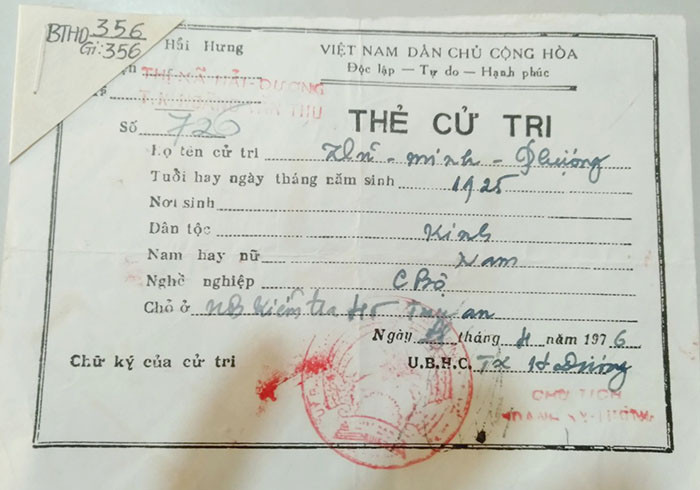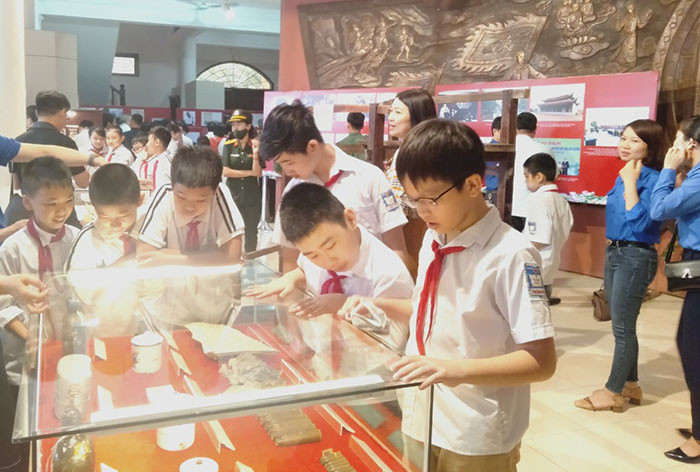The artifacts of the first General Election after the country's reunification are currently kept at the Provincial Museum, helping to visualize the atmosphere of the "national festival" after the North and South reunited.

Voter card of the 1976 General Election
45 years ago, on April 25, 1976, along with voters nationwide, Hai Duong voters enthusiastically went to vote for National Assembly (NA) deputies of unified Vietnam after nearly 1 year of the complete liberation of the South and the country's reunification.
Lots of valuable information
This May, the Provincial Museum will organize a special exhibition "Election of National Assembly Deputies and People's Council Deputies at all levels - National Day" with more than 200 documents and artifacts about the elections of National Assembly Deputies and People's Council Deputies at all levels. Among them, 18 artifacts about the General Election (GED) to elect National Assembly Deputies in 1976 stand out with special significance because this was the first year the country was reunited. These are: Notice of the Provincial Administrative Committee issued on March 1, 1976 on the list of the National Assembly Election Committee, the unification of provincial electoral areas; Directive No. 07 CT/TU dated February 7, 1976 on strengthening the leadership of the GED; Documents on GED published by the Propaganda Department of the Hai Hung Provincial Party Committee in 1976; Documents explaining the election day published by the Hai Hung Information Department in 1976; list of candidates, list of voters, brief biographies of candidates, ballots, voter cards, slogans, newspapers…
Through historical artifacts, it can be seen that the election in Hai Hung province at that time was prepared very carefully and meticulously. The propaganda about the election took place widely in newspapers and mass media as well as visual propaganda. In the document explaining the election day published by the Hai Hung Information Department in 1976, there was a paragraph: "Our people are the true owners of the country. All power in our country belongs to the people. Our state is elected by the people and is a tool for the people to exercise their right to mastery. The election is a democratic activity through which the people use their collective right to mastery to elect their own state and that state has no other obligation than to serve the people".
The artifacts provide valuable information about the 1976 TTC in Hai Hung (old), such as the whole province had 4 constituencies for electing National Assembly deputies and elected 20 deputies. The provincial election committee had 36 members. In particular, the artifacts of the ballots of voters in Quang Trung quarter showed one of the successes of the TTC when 100% of voters went to the polls. The whole province had 1,927 polling stations with 903,731 voters going to the polls, reaching 99.14%; 14 districts and towns had 99 - 100% of voters going to the polls.

Students visit the provincial museum
Collection efforts
Through historical artifacts, viewers can somewhat imagine the atmosphere of the "national festival" of the first TTC when the North and South reunited. Mr. Nguyen Danh Nhiem, a 55-year-old Party member in Sao Do ward (Chi Linh) said: "Now, I still remember the propaganda poems that were widely propagated that year: Each vote is a piece of steel to build the country/Vote for whom? For those who are passionate about society, for the country. Everyone is eager for election day to choose a worthy person to represent the people, contributing to building the country".
According to Mr. Tang Ba Hoanh, former Director of the Provincial Museum, during this period, the province had not yet established a museum, and the collection of documents and artifacts was handled by the Museum Department under the Hai Hung Department of Culture. In 1978, after returning from studying in Hanoi, Mr. Hoanh was assigned by his superiors to be in charge of collecting documents and materials synthesizing all economic, social, historical, and government-building issues in the province to gradually build the Provincial Museum. Many documents and materials about the 1976 TTC were collected during this period. In order to collect old documents and artifacts, the research and collection staff of the Museum Department had to work very hard. Mr. Hoanh and others had to make a list of National Assembly deputies from previous terms to request documents, materials, artifacts, and images about the elections. Except for the National Assembly deputies from other provinces or living too far away, the museum staff tried to visit each person's house. “At that time, collecting was more difficult than ever. Traveling was difficult, funding for archiving and collecting was limited, and the artifacts had no storage space and had to be stored at Quy Duong communal house (Cam Giang). However, we still tried our best to complete the task,” Mr. Hoanh recalled.
Thanks to the efforts of the researchers, collectors and preservers at the Provincial Museum, the remaining artifacts today have shown a part of the proud historical period of the nation. Reviewing the historical journey through the artifacts of the 1976 TTC, our people are even more proud and deeply aware of the great value and significance of the TTC, especially before the upcoming National Assembly and People's Council elections.
NGUYEN LIEN - VIET QUYNH